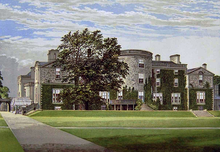Alan Plantagenet Stewart, 10th Earl of Galloway, KT, DL, JP (21 October 1835 – 7 February 1901), styled Lord Garlies until 1873, was a British peer and politician.
Alan Stewart, 10th Earl of Galloway | |
|---|---|
 Vanity Fair caricature by Melchiorre Delfico, February 1873. | |
| Lord High Commissioner to the General Assembly of the Church of Scotland | |
| In office 1876-1877 | |
| Member of Parliament for Wigtownshire | |
| In office 1868-1873 | |
| Personal details | |
| Born | 21 October 1835 |
| Died | 7 February 1901 (aged 65) |
| Spouse | |
| Children | 1+ |
| Parents |
|

Background
editGalloway was the eldest son of Randolph Stewart, 9th Earl of Galloway, and Lady Harriett Blanche, daughter of Henry Somerset, 6th Duke of Beaufort. He was educated at Harrow School and Christ Church, Oxford.[1]
Cricket
editHe played first-class cricket for the Marylebone Cricket Club between 1858 and 1864.[2]
Public life
editGalloway sat as Member of Parliament for Wigtownshire between 1868 and 1873. The latter year he succeeded to his father's earldom and estates, including the family seats of Galloway House and Cumloden House, and entered the House of Lords.[3]
He was also Lord High Commissioner to the General Assembly of the Church of Scotland from 1876 to 1877 and a justice of the peace and deputy lieutenant for Kirkcudbrightshire and Wigtownshire. In December 1887 he was appointed a Knight of the Thistle.[4]
Personal life
editLord Galloway married Lady Arabella Arthur, daughter of James Gascoyne-Cecil, 2nd Marquess of Salisbury, in 1872 (he was consequently the brother-in-law of Prime Minister Robert Gascoyne-Cecil, 3rd Marquess of Salisbury). Their daughter, Helen Stewart, married Neo-Jacobite Walter Clifford Mellor.[5] Lord Galloway died in February 1901, aged 65, and was succeeded in the earldom by his younger brother, Randolph. Lady Galloway died in August 1903.
On 14 October 1889, The Earl of Galloway appeared in Dumfries Sheriff Court on a charge of indecent behaviour towards a young girl. He was found 'not guilty'.[6]
On 23 January 1890, the Earl of Galloway appeared again in court, Glasgow Central Police Court, charged with having been 'riotous, disorderly or indecent' in his behaviour, by accosting, following and molesting Margaret Brown and one or more female passengers. The charge was found 'not proven'.[7]
He owned 79,000 acres in Scotland.[8]
Ancestry
edit| Ancestors of Alan Stewart, 10th Earl of Galloway | ||||||||||||||||||||||||||||||||||||||||||||||||||||||||||||||||||||||||||||||||||||||||||||||||||||||||||||||||||||||||||||||||||||||||||||||||||||||||||||||||||||||||||||||||||||||||||||||||||||||||||||||||||||||||||||||||||||||||||||||||||||||||||||||||||||||||||||||||||||||||||||||||||||||||||||||||||||||||||||||||||||||||||||||||||||||||||||||||||||||||||||||||||||||||||||||||||||||||||||||||||||||||||||||||||||||||||||||||||||||||||||||||||||||||||||||||||||||||||||||||||||||||||||||||||||||||||||||||||||||||||||||||||||||||||||||||||||||||||||||||||||||||||||||||||||||||||||||||
|---|---|---|---|---|---|---|---|---|---|---|---|---|---|---|---|---|---|---|---|---|---|---|---|---|---|---|---|---|---|---|---|---|---|---|---|---|---|---|---|---|---|---|---|---|---|---|---|---|---|---|---|---|---|---|---|---|---|---|---|---|---|---|---|---|---|---|---|---|---|---|---|---|---|---|---|---|---|---|---|---|---|---|---|---|---|---|---|---|---|---|---|---|---|---|---|---|---|---|---|---|---|---|---|---|---|---|---|---|---|---|---|---|---|---|---|---|---|---|---|---|---|---|---|---|---|---|---|---|---|---|---|---|---|---|---|---|---|---|---|---|---|---|---|---|---|---|---|---|---|---|---|---|---|---|---|---|---|---|---|---|---|---|---|---|---|---|---|---|---|---|---|---|---|---|---|---|---|---|---|---|---|---|---|---|---|---|---|---|---|---|---|---|---|---|---|---|---|---|---|---|---|---|---|---|---|---|---|---|---|---|---|---|---|---|---|---|---|---|---|---|---|---|---|---|---|---|---|---|---|---|---|---|---|---|---|---|---|---|---|---|---|---|---|---|---|---|---|---|---|---|---|---|---|---|---|---|---|---|---|---|---|---|---|---|---|---|---|---|---|---|---|---|---|---|---|---|---|---|---|---|---|---|---|---|---|---|---|---|---|---|---|---|---|---|---|---|---|---|---|---|---|---|---|---|---|---|---|---|---|---|---|---|---|---|---|---|---|---|---|---|---|---|---|---|---|---|---|---|---|---|---|---|---|---|---|---|---|---|---|---|---|---|---|---|---|---|---|---|---|---|---|---|---|---|---|---|---|---|---|---|---|---|---|---|---|---|---|---|---|---|---|---|---|---|---|---|---|---|---|---|---|---|---|---|---|---|---|---|---|---|---|---|---|---|---|---|---|---|---|---|---|---|---|---|---|---|---|---|---|---|---|---|---|---|---|---|---|---|---|---|---|---|---|---|---|---|---|---|---|---|---|---|---|---|---|---|---|---|---|---|---|---|---|---|---|---|---|---|---|---|---|---|---|---|---|---|---|---|---|---|---|---|---|---|---|---|---|---|---|---|---|---|---|---|---|---|---|---|---|---|---|---|---|---|---|---|---|---|---|---|---|---|---|---|---|---|---|---|---|---|---|---|---|---|---|---|---|---|---|---|---|---|---|---|---|---|---|---|---|---|---|---|---|---|---|---|---|---|---|---|---|---|---|---|---|---|---|---|---|---|---|---|---|---|---|---|---|---|---|---|---|---|---|---|---|---|---|---|---|---|---|---|---|---|---|---|---|---|---|---|---|---|---|---|---|---|---|---|---|---|---|---|---|---|---|---|---|---|---|---|---|---|
| ||||||||||||||||||||||||||||||||||||||||||||||||||||||||||||||||||||||||||||||||||||||||||||||||||||||||||||||||||||||||||||||||||||||||||||||||||||||||||||||||||||||||||||||||||||||||||||||||||||||||||||||||||||||||||||||||||||||||||||||||||||||||||||||||||||||||||||||||||||||||||||||||||||||||||||||||||||||||||||||||||||||||||||||||||||||||||||||||||||||||||||||||||||||||||||||||||||||||||||||||||||||||||||||||||||||||||||||||||||||||||||||||||||||||||||||||||||||||||||||||||||||||||||||||||||||||||||||||||||||||||||||||||||||||||||||||||||||||||||||||||||||||||||||||||||||||||||||||
References
edit- ^ "The Late Earl Of Galloway". The Times. 4 January 1873. Retrieved 14 October 2024 – via The Times Digital Archive.
- ^ "Player profile: Alan Plantagenet Stewart". CricketArchive. Retrieved 26 August 2011.
- ^ "No. 23952". The London Gazette. 25 February 1873. p. 782.
- ^ "The Queen has been pleased to approve the". The Times. 16 December 1887. Retrieved 14 October 2024 – via The Times Digital Archive.
- ^ Fletcher, Ian (1987). W.B. Yeats and his contemporaries. Harvester. ISBN 978-0-7108-0613-0.
- ^ "Charge Against Lord Galloway". The Times. 15 October 1889. Retrieved 14 October 2024 – via The Times Digital Archive.
- ^ "Charge Against Lord Galloway". The Times. 24 January 1890. Retrieved 14 October 2024 – via The Times Digital Archive.
- ^ The great landowners of Great Britain and Ireland